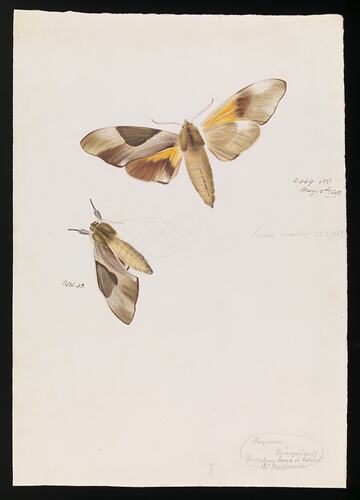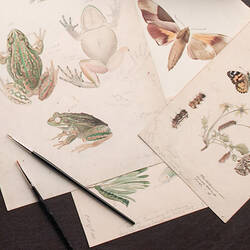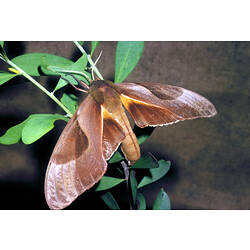Summary
This scientific illustration by Arthur Bartholomew was commissioned by Sir Frederick McCoy, Director of Museum Victoria as part of his zoological research. It forms part of the much larger Prodromus Collection. Many of the original illustrations in the collection informed the production of the two volume work 'The Prodromus of the Zoology of Victoria' which was Museum Victoria's first major publication from 1878. The Prodromus project followed a popular formula of the time, seeking to identify and classify the natural wonders of the 'new world'.
For over 40 years McCoy would bring specimens to Bartholomew observe and nuture specifically for illustration. Bartholomew was methodical and the quality of illustrations was both consistent and flawless. Bartholomew would first describe their form with fine pencil lines, before building up overlapping washes of watercolour and eventually adding glazes of varnish and gum Arabic. At last he would capture the colour saturation and level of sheen in each part of the specimen, achieving a subtle three-dimensionality reproducing both likeness and texture. Bartholomew would faithfully illuminate each life stage of the insect, noting the date of each successive metamorphosis. Once the perfect imago (adult insect) had emerged (as pictured here), the species would be identified, pinned and entered into the collection.
Publications such as the Prodromus reached a peak in popularity with the work of John Gould in England and the earlier work of James Audobon in America. In Australia, many professional and amateur publications, including Aldine's systematic studies of the colonies and Louise Anne Meredith's Bush Friends From Tasmania, contributed to the genre.The publication of the Prodromus was an enormous undertaking, utilising the work of numerous artists, collectors, lithographers and publishers, over an extended period of time. McCoy died without completing his systematic study, but even at the time few believed that 'any of us will live to witness the completion of the work, if the entire Fauna of Victoria is to be illustrated.'Although costly in both financial and professional terms, it was met with critical acclaim and wide popular support. Financial battles were waged and lost by McCoy, but ultimately the Prodromus has stood the test of time and remains one of Museum Victoria's finest publications.
Description of Content
Double Headed Hawk Moth, Coequosa triangularis by Arthur Bartholomew. Pencil, watercolour and ink illustration D349, on paper, May 15 1862, 20 cm x 29 cm. Commissioned by Frederick McCoy as part of his zoological research.
More Information
-
Collection Names
-
Collecting Areas
-
Artist
-
Technique
Scientific illustration
-
Drawing Number
349 & 353
-
State
Illustration
-
Primary Inscriptions
D 349.NS. / May 15th 1862. / [figure numbers for drawing 349, 353 & 267]
-
Secondary Inscriptions
Larva drawing 282, 267.
-
Tertiary Inscriptions
Caquosa / triangularis / Imago from larva in Cabinet / Nr Melbourne
-
Classification
-
Taxon Name
-
Author and date of publication
(Pfitzner, 1805)
-
Preferred Common name
Double-headed Hawk Moth
-
Kingdom
-
Phylum
-
Subphylum
-
Class
-
Order
-
Superfamily
-
Family
-
Subfamily
-
Genus
-
Species Name
triangularis
-
Category
-
Discipline
-
Type of item
-
Overall Dimensions
20 cm (Width), 29 cm (Height)
-
Dimensions
195 mm (Length), 278 mm (Width)
Measurement From Conservation.



